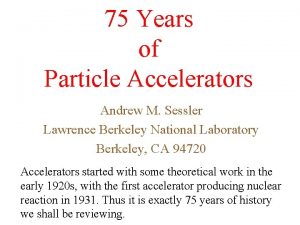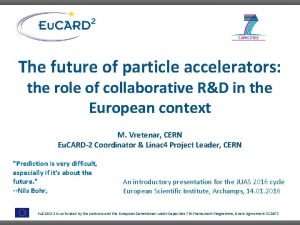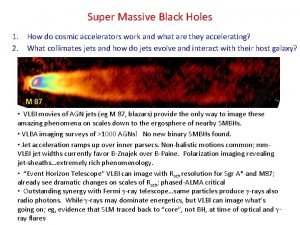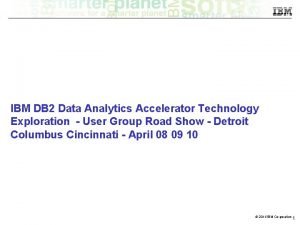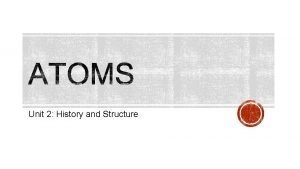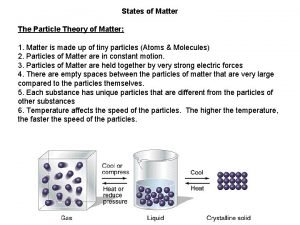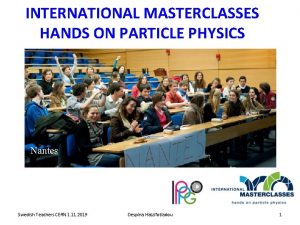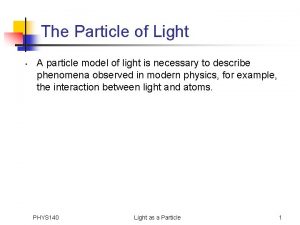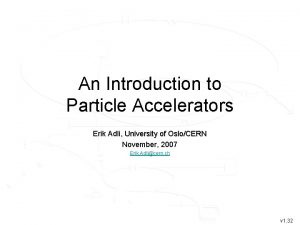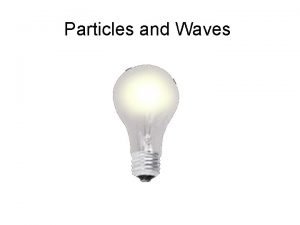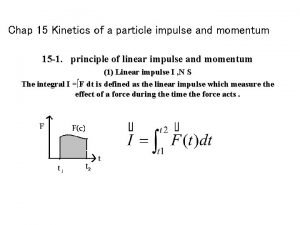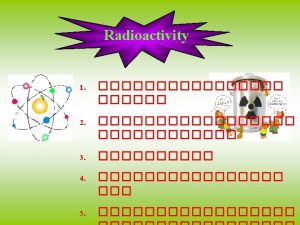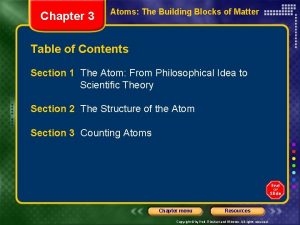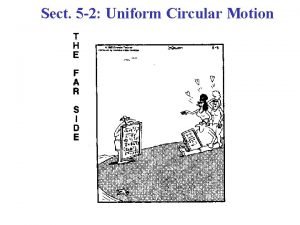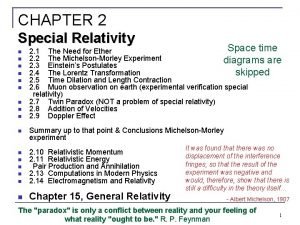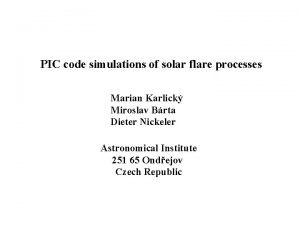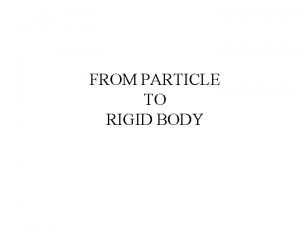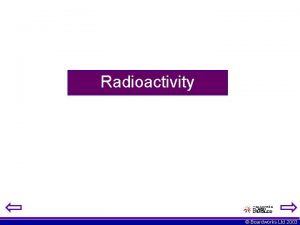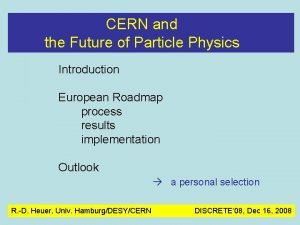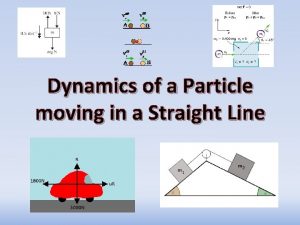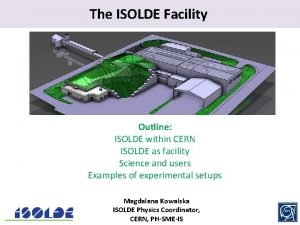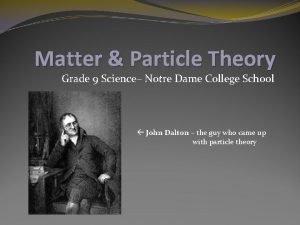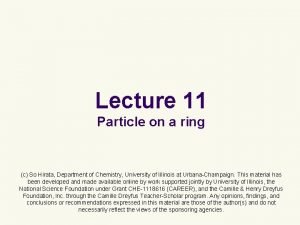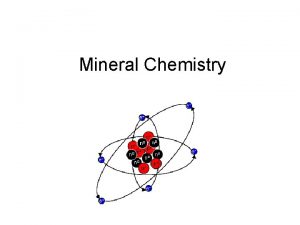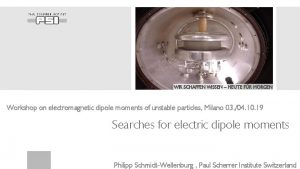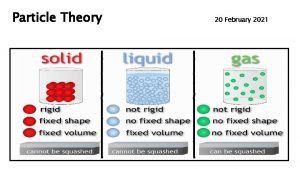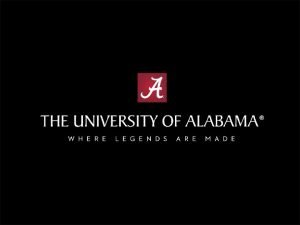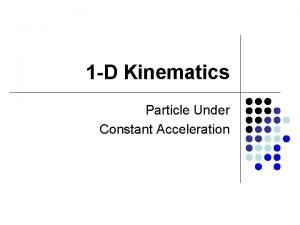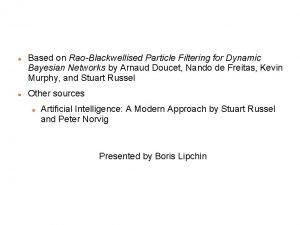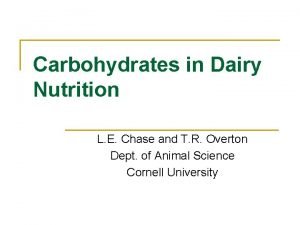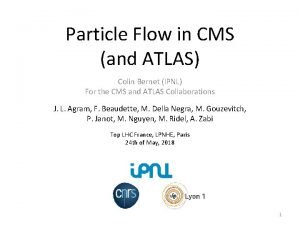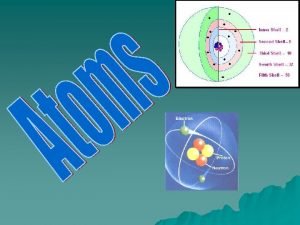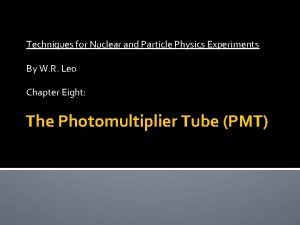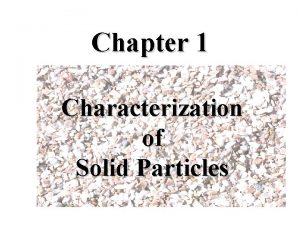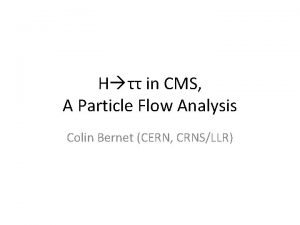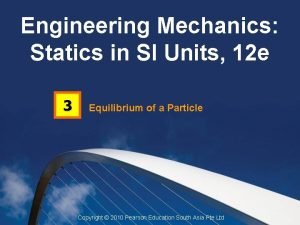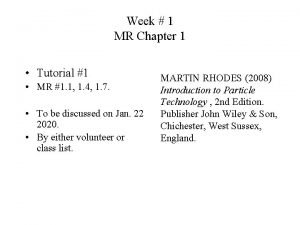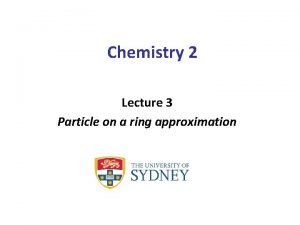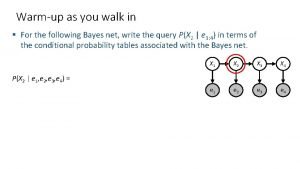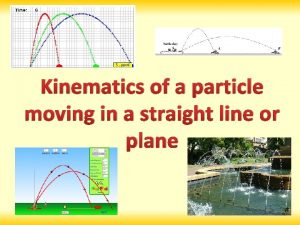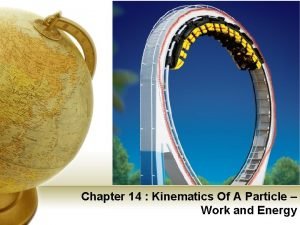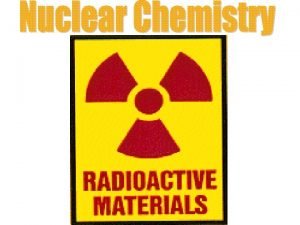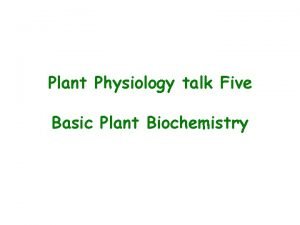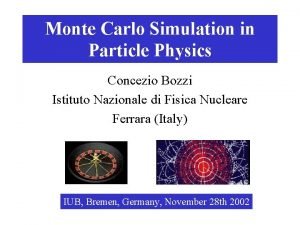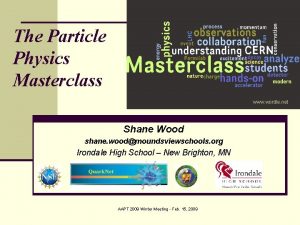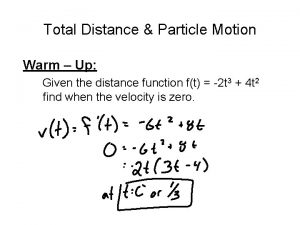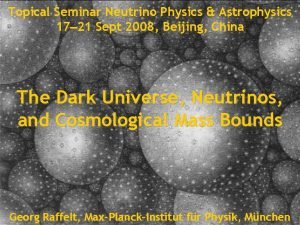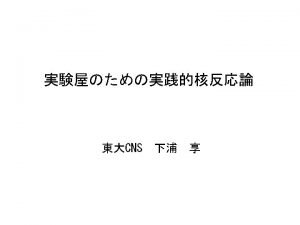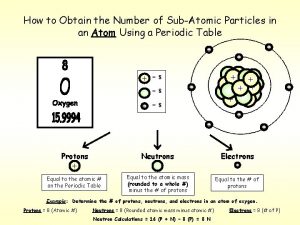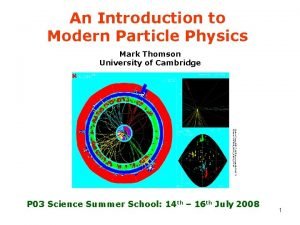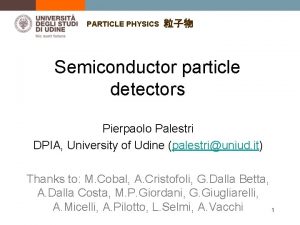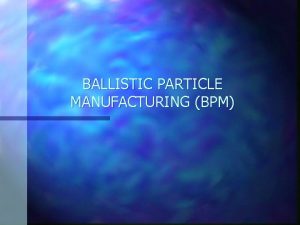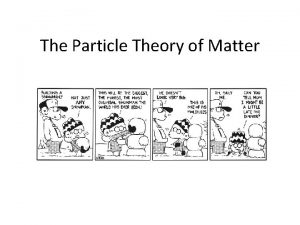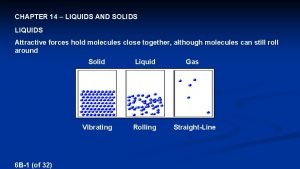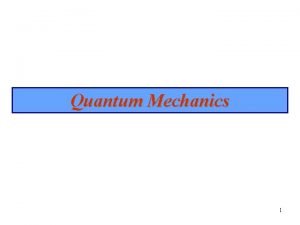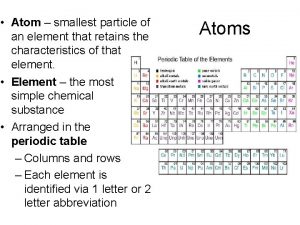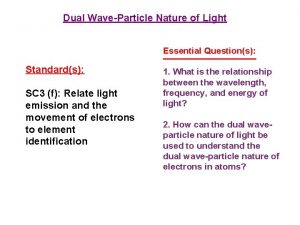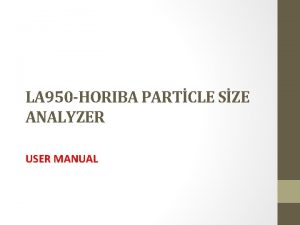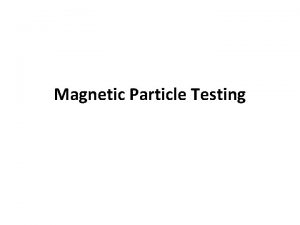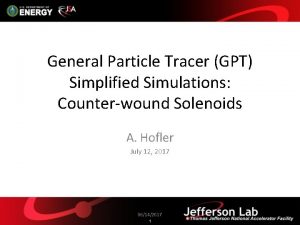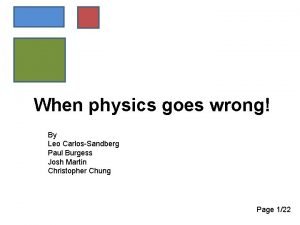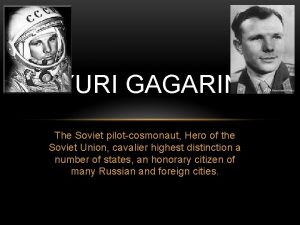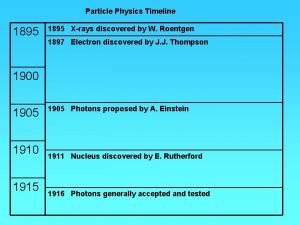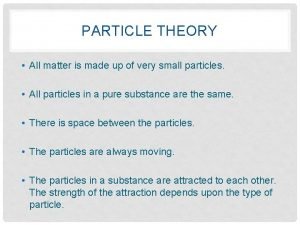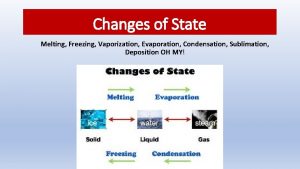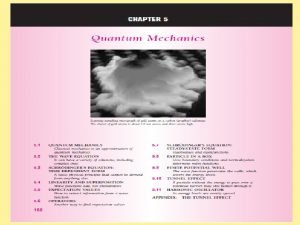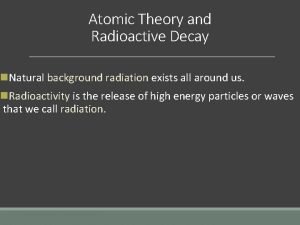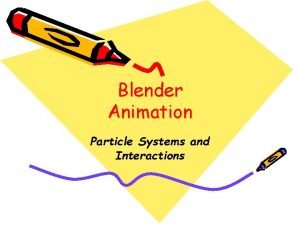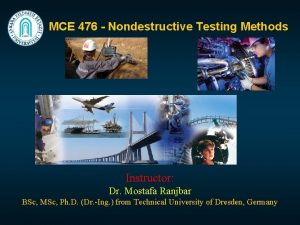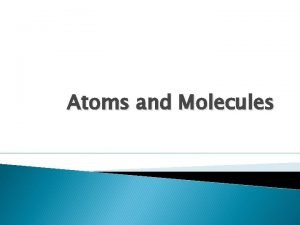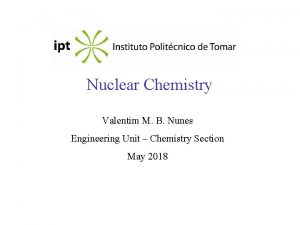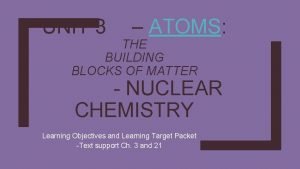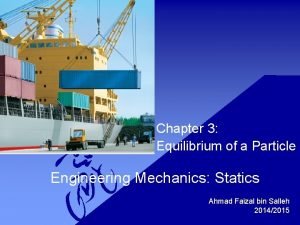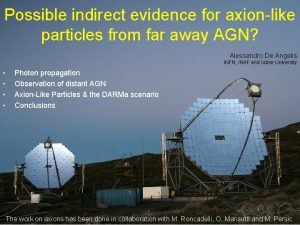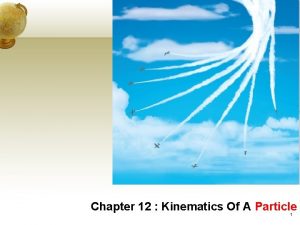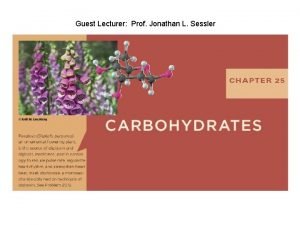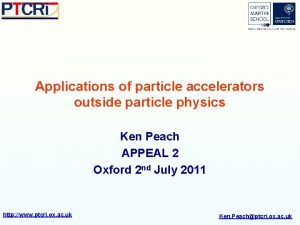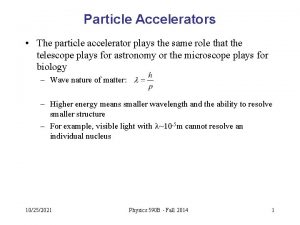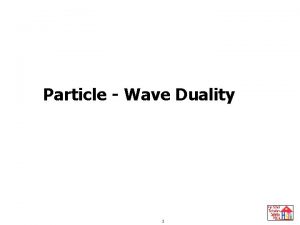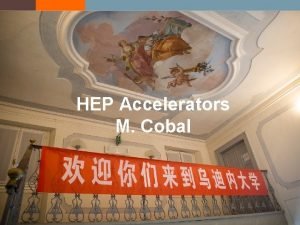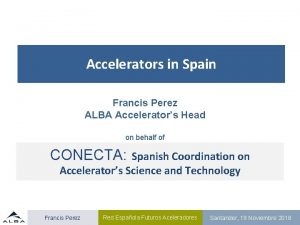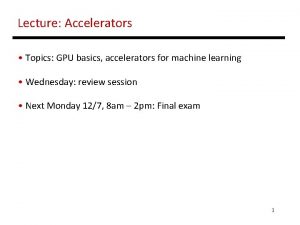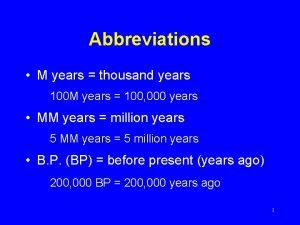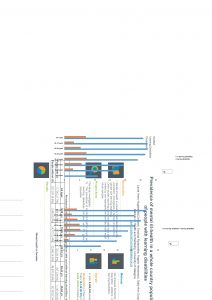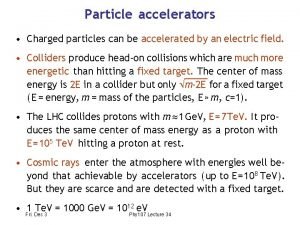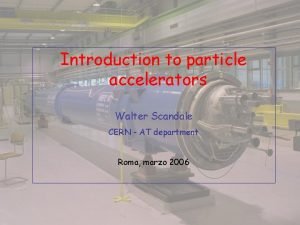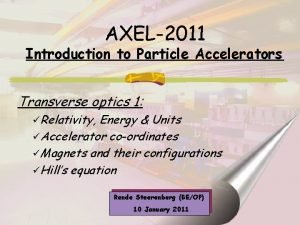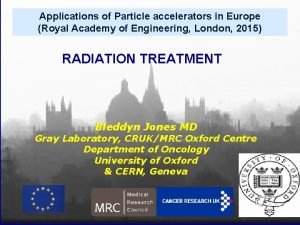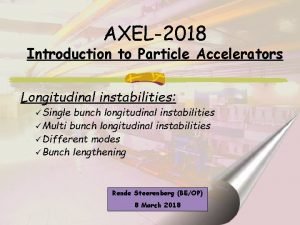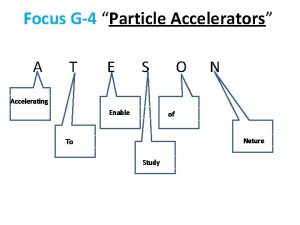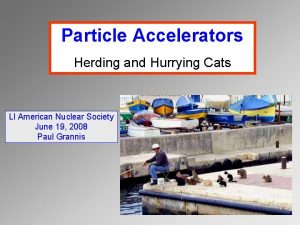75 Years of Particle Accelerators Andrew M Sessler









































































































- Slides: 105

75 Years of Particle Accelerators Andrew M. Sessler Lawrence Berkeley National Laboratory Berkeley, CA 94720 Accelerators started with some theoretical work in the early 1920 s, with the first accelerator producing nuclear reaction in 1931. Thus it is exactly 75 years of history we shall be reviewing.

Motivation The first motivation was from Ernest Rutherford who desired to produce nuclear reactions with accelerated nucleons. For many decades the motivation was to get to ever higher beam energies. At the same time, and especially when colliding beams became important, there was a desire to get to ever higher beam current. In the last three decades there has been motivation from the many applications of accelerators, such as producing X-ray beams, medical needs, ion implantation, spallation sources, and on.

Table of Contents I. Electrostatic Machines II. Cyclotrons III. Linacs IV. Betatrons V. Synchrotrons VI. Colliders VII. Synchrotron Radiation Sources VIII. Cancer Therapy Machines IX. The Future X. Concluding Remarks

I. Electrostatic Accelerators I. 1 I. 2 Voltage Multiplying Columns and Moving Belts Tandems

I. 1 Voltage Multiplying Columns The first accelerator that produced a nuclear reaction was the voltage multiplying column that Cockcroft and Walton built from 1930 to 1932. A small voltage was applied to condensers in parallel, and then by a spark gap, they were fired in series and produced a large voltage. At about the same time Van de Graaff developed moving belts that turned mechanical energy into electrostatic energy.

The original Cockcroft-Walton installation at the Cavendish Laboratory in Cambridge. Walton is sitting in the observation cubicle (experimental area) immediately below the acceleration tube.

The Cockcroft-Walton preaccelerator, built in the late 1960 s, at the National Accelerator Laboratory in Batavia, Illinois.

Van de Graaff's very large accelerator built at MIT's Round Hill Experiment Station in the early 1930 s.

Under normal operation, because the electrodes were very smooth and almost perfect spheres, Van de Graaff generators did not normally spark. However, the installation at Round Hill was in an open-air hanger, frequented by pigeons, and here we see the effect of pigeon droppings.

I. 3 Tandems It was soon appreciate that a negative ion (say H-) could be accelerated by a positive electrostatic column, stripped of its electron (to say H+) and accelerated again so that one obtained twice the energy that previously had been obtained. These “swindletrons”, so-named by Luis Alvarez, later called tandems, are now in common use and, generally, are commercially made.

A tandem accelerator at ORNL, built by the National Electrostatics Corporation. The high-voltage generator, is located inside a 100 -ft-high, 33 -ftdiameter pressure vessel.

II. Cyclotrons II. 1 II. 2 II. 3 II. 4 Lawrence and the Early Cyclotrons Transverse Focusing and Phase Focusing Calutrons FFAG and Spiral Sector Cyclotrons

1. 2. 3. 4. 5. 6. 7. Major Nuclear Advances of the 1930 s (My opinion) Accelerator produced nuclear reactions, Cockcroft and Walton, England, (1932), Nobel Prize 1951 2. Accelerator produced radioactivity, F. Joliot and Irene Joliot-Curie, France, Nobel Prize 1935 3. Slow neutron reactions, Fermi, Italy, Nobel Prize 1938 4. Nuclear fission, Otto Hahn, (1939), Germany, Nobel Prize 1944 (today Strassmann would be included; and a separate prize given to Lise Meitner and Otto Frisch) 8. None of these advances were in Berkeley. Unfortunately, there was too much focus on machine development. Howeve for just that, Lawrence received the Nobel Prize in 1939 (today, Stan Livingston would be included).

Celebrating our 75 th Anniversary E. O. Lawrence in 1930

The First Cyclotron Five inches in diameter.

The Original Rad Lab Located on the Campus near Le Conte Hall.

II. 1 Lawrence and the Early Cyclotrons As we all know, Lawrence invented and made a succession of cyclotrons. Perhaps his greatest contribution was, however, the creation of a laboratory where physicists, engineers, biologist worked together to achieve far more that any one discipline could accomplish. Cyclotrons are still built for nuclear physics and medical purposes, but not for high-energy physics reasons.

A picture of the 11 -inch cyclotron built by Lawrence and his graduate students, David Sloan and M. Stanley Livingston, during 1931.

The 60 Inch Cyclotron Donald Cooksey and E. O. Lawrence

The 60 -inch cyclotron. The picture was taken in 1939.

II. 2 Transverse Focusing and Phase Focusing The transverse focusing of particles was developed, by Stan Livingston and was crucial in making the very first cyclotron work. (He also realized how to remove the accelerating field foils and thus increase cyclotron intensity by orders of magnitude. ) Longitudinal, or phase focusing was developed in 1944, independently by Ed Mc. Millan and Vladimir Veksler. The concept made the 184 -inch work, and has been used in essentially all accelerators since that time.

The magnet of the 184 -inch cyclotron.

II. 3 Calutrons The concept of electromagnetic separation of the isotopes of uranium, U 238 and U 235, only the later, which is only 1/2% of natural uranium, being fissionable, was developed by E. O. Lawrence. A first demonstration was made on the not-yet-completed 184’’, and soon Oak Ridge with 1000 calutrons was established. Although all the material for the Hiroshima bomb was electromagnetically separated, that method has not been used since WWII and, as we all know, centrifuges are now the method of choice.

The "C" shaped alpha calutron tank. Here an early version is shown.

II. 4 FFAG In the early 1950’s, just after the development of strong focusing (described in the next section), it was realized by the Midwestern Research Group (MURA), that it was possible to have many configurations of an accelerator, and some of these configurations were advantageous for various purposes. In particular they developed the concept of fixed field (fixed in time) alternating gradient (FFAG) accelerators. Spiral ridge cyclotrons have been extensively employed for nuclear physics studies (88”) and, today, various other applications of FFAG are being considered.

The “Mark 2”. A spiral sector FFAG built by the MURA Group in Wisconsin from 1956 to 1959.

TRIUMF, the world's largest cyclotron at Canada's National Laboratory for Particle and Nuclear Physics. (520 Me. V). The machine started in 1974 and is still in operation (now for rare isotope acceleration).

III. Linear Accelerators III. 1 Proton and Heavy Ion Linacs III. 2 Induction Linacs III. 3 Electron Linacs

III. 1 Proton and Heavy Ion Linacs Luis Alvarez was the first one to maker a linear accelerator that only involved a single frequency. In the 60’s radio frequency RFQs were invented in the Soviet Union by V. A. Teplyakov, with actual construction pioneered by a group at Los Alamos

An accelerating tank of the first, Alvarez, linac built just after WWII.

The Materials Testing Accelerator (MTA), built, in the early 1950 s, at a site that would later become the Lawrence Livermore Laboratory. The purpose of the machine was to produce nuclear material, but it never produced any (due to uncontrollable sparking).

The inside of a Radio Frequency Quadrupole. The RFQ has replaced the very large Cockroft-Waltons as injectors in to synchrotrons.

III. 2 Induction Linacs First invented, at Livermore, for magnetic confined fusion. Used for the Electron Ring Accelerator at LBL. Then used to study nuclear weapon implosions at LLNL and LANL. And, also, the basis of LBL work on heavy ion fusion (but that program has been terminated by the US Government).

The world’s first induction accelerator, Astron, built at the Lawrence Livermore Laboratory in the late 1950 s and early 1960 s by Nick Christofilos.

The induction accelerator, FXR, built, at Lawrence Livermore, in order to study the behavior of the implosion process in nuclear weapons. The facility was completed in 1982.

The Dual Axis Radiological Hydrodynamic Test Facility (DARHT) at the Los Alamos National Laboratory, New Mexico. This device is devoted to examining nuclear weapons from two axes rather than just one. This reveals departures from cylindrical symmetry which is a sign of aging which can seriously affect performance.

III. 3 Electron Linacs The high powered klysron was invented, during WWII, by The Varian Brothers and Ed Ginzton. Using it, Bill Hansen invented the electron linac. A succession of machines at Stanford culminated in the two-mile accelerator, SLAC, led by WKH Panofsky. That machine made many important high-energy physics discoveries and then became the injector for PEP and PEP II, and now has become the LCLS.

The SLAC site.

IV. Betatrons Very few betatrons are built these days, but at the time, around the 1940’s, they were very important for they provided the only way to accelerate electrons to higher energies than could be obtained with electrostatic machines. Many physicists had tried to make circular electrons accelerators, but they all failed until Don Kerst was able to make a betatron by careful attention to the details of particle orbit dynamics. One of his early machines was used at Los Alamos during WWII.

One of the first betatrons, built in the early 1940 s. The so -called 20 inch machine at the University of Illinois.

A picture of the 100 Me. V betatron (completed in the early 1940 s) at the G. E. Research Laboratory in Schenectady after Kerst had returned to the University of Illinois.

A modern, very compact betatron, commercially produced. It is used to produce x-rays to look for defects in large forgings, steel beams, ship’s hulls, pressure vessels, engine blocks, bridges, etc.

V. Synchrotrons V. 1 First Synchrotrons V. 2 Strong Focusing Made possible by the synchrotron (RF) concept, the concept of strong focusing, and the concept of cascading synchrotrons. First proposed, even prior to the invention of strong focusing, by the Australian, Macus Oliphant. They were first built after WWII and all modern accelerators are based upon the synchrotron principle.

V. 1 First Synchrotrons

Late in World War II the Woolwich Arsenal Research Laboratory in the UK had bought a betatron to "X-ray" unexploded bombs in the streets of London. Frank Goward converted the betatron into the first “proof of principal” synchrotron.

This 300 Me. V electron synchroton at the General Electric Co. at Schenectady, built in the late 1940 s. The photograph shows a beam of synchrotron radiation emerging.

Although the first Proton Synchrotron to be planned, this 1 Ge. V machine at Birmingham University, achieved its design goal only in 1953.

The 3 Ge. V Cosmotron was the first proton synchrotron to be brought into operation.

Overview of the Berkeley Bevatron during its construction in the early 1950 s. One can just see the man on the left.

V. 2 Strong Focusing The invention of strong focusing, in the early 1950’s, by Ernie Courant, Hartland Snyder and Stan Livingston, revolutionized accelerator design in that it allowed small apertures (unlike the Bevatron whose aperture was large enough to contain a jeep, with its windshield down). The concept was independently discovered by Nick Christofilos.

The CERN site in April 1957 during construction of the 26 Ge. V Proton-Synchrotron (PS).

An artists impression of the AGS before its construction in the 1950 s.

Fermilab’s superconducting Tevatron can just be seen below the red and blue room temperature magnets of the 400 Ge. V main ring.

VI. Colliders VI. 1 Early Colliders VI. 2 Proton – Antiproton Colliders VI. 3 The Large Hadron Collider (LHC) and the Heavy-Ion Collider (RHIC)

VI. 1 Early Colliders In the 1950’s a number of places, MURA, Novosibirsk, CERN, Stanford, Frascati, and Orsay, developed the technology of colliding beams. Bruno Touschek, Gersh Budker and Don Kerst were the people who made this happen. Colliders are now the devices employed to reach the highest energies.

The electron-electron storage rings (early 1960 s), at the High Energy Physics Laboratory (HEPL) on the Stanford Campus.

The first electronpositron storage ring, Ad. A. (About 1960) Built and operated at Frascati, Italy and later moved to take advantage of a more powerful source of positrons in France.

ADONE, the first of the large electron-positron storage rings. Operation commenced in 1969.

Superconducting RF cavities at the CERN Large Electron Positron Collider (LEP).

The CERN Electron Storage and Accumulation Ring (CESAR) was built, in the 1960’s, as a studymodel for the ISR (Intersecting Storage Rings).

The first proton-proton collider, the CERN Intersecting Storage Rings (ISR), during the 1970’s. One can see the massive rings and one of the intersection points.

VI. 2 Proton – Antiproton Colliders It was the invention of stochastic cooling, by van de Meer, that made proton-anti-proton colliders possible

In 1977 the magnets of the “g-2” experiment were modified and used to build the proton-antiproton storage ring: ICE (the Initial Cooling Experiment). The ring verified the stochastic cooling method, and allowed CERN to discover the W and Z.

The anti-proton source, the “p-bar” source, built in the 1990’s at Fermilab. The reduction in phase space density, the proper measure of the effectiveness of the cooling, is by more than a factor of 1011.

VI. 3 The Large Hadron Collider (LHC) and the Heavy-Ion Collider (RHIC) The LHC, at CERN, is soon to be completed. It is the primary tool to which high-energy physicists are looking. The hope is to discover the Higgs particle. The machine is 28 km in circumference. RHICis in operation at Brookhaven, a development of studies started in Berkeley, on the Bevalac, in the late 1970’s.

Nuclear matter under extreme conditions of very high density and very high temperature similar to the conditions in the original Big Bang. A collision of a nucleus of gold with a nucleus of gold. The temperature rises to 2 trillion degrees Kelvin and as many as 10, 000 particles are born in the resulting fireball.

VII. Synchrotron Radiation Sources VII. 1 Synchrotron X-Ray. Sources VII. 2 Linear Coherent Light Source and the European Union X-Ray Free Electron Laser

VII. 1 Synchrotron X-Ray Sources At first (about 1970’s), accelerators built for high-energy physics were used parasitically, but soon machines were specially built for this important application. There are more than 50 synchrotron radiation facilities in the world. In the US there are machines in Brookhaven (NSLS), Argonne (APS), SLAC: SPEAR and the LCLS, and at LBL (ALS).

This intricate structure of a complex protein molecule structure has been determined by reconstructing scattered synchrotron radiation.

An aerial picture of the European Synchrotron Radiation Facility (ESRF) located in Grenoble, France. Construction was initiated in 1988 and the doors were open for users in 1994.

Aerial view of Spring 8, a synchrotron light source located in Japan. Construction was initiated in 1991 and “first light” was seen in 1997.

The King of Jordan discussing with scientists the Sesame Project, which will be located in Jordan and available to all scientists.

VII. 2 Linear Coherent Light Source and the European Union X-Ray Free Electron Laser FELs, invented in the late 1970’s at Stanford are now becoming the basis of major facilities in the USA (SLAC) and Europe (DESY). They promise intense coherent Radiation. The present projects expect to reach radiation of 1 Angstrom (0. 1 nano-meters, 10 killo-volt radiation)

The DESY Free Electron Laser magnetic wiggler. It produces laser light in the ultra-violet and x-ray regions of the spectrum.

The SLAC site showing its two-mile long linear accelerator, the two arms of the SLC linear collider, and the large ring of PEPII. This is where the LCLS will be located.

A schematic of a possible fourth generation light source. This is the proposed facility LUX, as envisioned by a team at LBL, but upon which we were told (strongly) to stop work.

VIII. Cancer Therapy Machines First treatment by the Lawrence's of their mother. Stone in the late 30’ and neutrons. (Sad story) Linacs for x-rays built by Siemans and Varian in the US Hadron therapy (Bragg peak) suggested by Bob Wilson in 1946. Pioneered in Berkeley and Harvard. Now 5 facilities in US; many more to come. Heavy ions carefully developed at the Bevalac in the 70’s. From basic biology to patient treatment. First dedicated facility in Japan. None in US, but more being built in Japan and some in Europe. Most patients, however, are treated by by X-rays

A modern system for treating a patient with x-rays produced by a high energy electron beam. The system, built by Varian, shows the very precise controls for positioning of a patient. The whole device is mounted on a gantry. As the gantry is rotated, so is the accelerator and the resulting x-rays, so that the radiation can be delivered to the tumor from all directions.

A drawing showing the Japanese (two) proton ion synchrotron, HIMAC. The pulse of ions is synchronized with the respiration of the patient so as to minimize the effect of organ movement.

IX. The Future 1 The International Linear Collider (ILC) 2 Spallation Neutron Source 3 Rare Isotope Accelerator and FAIR 4 Neutrino Super Beams, Neutrino Factories and Muon Colliders 5 Accelerators for Heavy Ion Fusion 6 Proton Drivers for Power Reactors 7 Lasers and Plasmas

1. The International Linear Collider (ILC) The next high-energy physics facility. Cost estimate is due at the end of the year (clearly in the few billion dollar range). World-wide effort. A major report has strongly requested that the USA bid for location in the USA. (With LEP, HERA, the KEK B-Factory, and LHC the past couple of decades have been tough. If the ILC is not located in the USA there won’t be any HEP facility in our country as both the Tevatron and PEPII are scheduled to be terminated in this decade.

The X-Band Test Accelerator at SLAC. Here one of the approaches to an International Linear Collider was tested by actually building a section of a collider. It is not the approach of choice.

The damping ring built at KEK, Japan, in order to study the process of making a beam of very tiny dimensions as would be needed for the International Linear Collider.

TESLA technology: these superconducting accelerator structures are built of niobium, and are the crucial components of the International Linear Collider.

2. Spallation Neutron Sources A joint effort of LBL, BNL, LANL, J-Lab and Oak Ridge. Located at Oak Ridge. A similar facility is under construction in Japan, with advanced plans in China and plans (for a long time) in Europe.

An overview of the Spallation Neutron Source (SNS) site at Oak Ridge National Laboratory showing the various components of the facility.

A diagram showing the CERN approach to a linear collider. The two main linacs are driven by 30 GHz radio frequency power derived from a drive beam of low energy but high intensity that will be prepared in a series of rings.

A three dimensional -- blown apart -- drawing showing how a Time Projection Chamber (TPC) works.

A picture of the UA 2 detector at CERN. One can easily imagine that the detectors about a modern storage ring are as complicated, and about as expensive as the accelerator itself.

An “exploded” diagram of the ATLAS detector, presently under constrtuction, for the LHC.

3. Rare Isotope Accelerator and FAIR Thinking and plans in the US (Argonne and Michigan State), but they have been told to stop, but I think it is getting reversed. (First priority in nuclear physics) Meanwhile, Germany has started FAIR.

The Rare Isotope Accelerator (RIA) scheme. The heart of the facility is composed of a driver accelerator capable of accelerating every element of the periodic table up to at least 400 Me. V/nucleon. Rare isotopes will be produced in a number of dedicated production targets and will be used at rest for experiments, or they can be accelerated to energies below or near the Coulomb barrier.

4. Neutrino Super Beams, Neutrino Factories, and Muon Colliders Solar Neutrino Problem Super K K to. K Gran Saso Minos and NUMI Super Beams Neutrino Factories Muon Colliders

Here we show the very large underground detector, Kamiokande, located in the mountains of Japan. Many very important results have come from this facility that first took data in 1996. The facility was instrumental in solving “the solar neutrino problem. After a serious accident the facility was fully restored in 2005 and this year the Super. Kamiokande, SK-III will be completed.

A diagram of the muon cooling experiment MICE being carried out at the Rutherford-Appleton Laboratories in England.

5. Accelerators for Heavy Ion Fusion Started in 1974 Two programs: Europe: Use of RF linac and accumulating rings. USA: Use an induction linac. Both approaches should work. Both have been stopped for lack of government support. The USA program was terminated a year of so ago, as we clearly don’t need to do R&D on new energy sources.

An artist’s view of a heavy ion inertial fusion facility. Although the facility is large, it is made of components that all appear to be feasible to construct and operate.

6. Proton Drivers for Power Reactors The idea is to have a sub-critical nuclear power reactor (hence very safe) and drive the reactor into criticality with neutrons produced by protons as in a spallation source. Also, there is the possibility of both burning thorium and burning up long-lived fission products. Actively being studied in Japan, Russia, Europe, and in the USA there has been some small activity. Now, perhaps, with The Global Nuclear Energy Partnership, there will be more.

A linac scheme for driving a reactor. These devices can turn thorium into a reactor fuel, power a reactor safely, and burn up long -lived fission products.

7. Lasers and Plasmas The idea of using a plasma as an accelerating media was proposed in 1979 by John Dawson and Toji Tajima. Since, then, there has been a great deal of activity, with UCLA, LBL, Rutherford-Appleton, and others, being places of great activity. High gradient, and major acceleration, has been achieved.

The SLAC End Station which was used to study the very fine final focus required for the International Linear Collider. It is in this area, and using the very intense beam developed for the earlier study, that the experiments on wake-field acceleration were carried out.

X. Concluding Remarks Accelerator Milestones Cockcroft-Waltons (England) Van de Graaffs (MIT) Cyclotrons (Berkeley) Betatrons (Illinois) Synchrotrons (Soviet Union and Berkeley) Strong Focusing (Brookhaven) FFAG (Mid-West) Proton Linacs (Berkeley) Electron Linacs (Stanford) Heavy Ion Accelerators (Berkeley) Induction Linacs (Livermore, Berkeley) Space Charge Effects (Many places, but also Berkeley) Cooling: Stochastic and Electron (CERN and Soviet Union)

X. Concluding Remarks Accelerator Milestones (Cont) Colliding Beams of Protons (Mid-West) Colliding Beams of Electrons (Stanford, Italy, Soviet Union) Colliding Beams of Protons and Anti-Protons (CERN) RFQs (Soviet Union and Los Alamos) FELs (Stanford) Photo-cathodes (Los Alamos) Medical Applications (Berkeley) SC Magnets (Fermilab, Brookhaven, CERN, Berkeley) SC RF (Stanford, Cornell, CERN, J-Lab, KEK) Light Sources and Insertion Devices (Stanford, Berkeley)

X. Conclusion I have sketched for you some of the likely future projects of accelerator physics future. Perhaps, the development of accelerators was a passing moment in the history of mankind, but it is much more likely to be an activity that will continue, producing devices not only for physics, but for an ever increasing catalogue applications enriching our everyday lives.

Thank you for your attention.
 Andrew sessler
Andrew sessler The long-term future of particle accelerators
The long-term future of particle accelerators Good to great technology accelerators
Good to great technology accelerators Good to great chapter 6
Good to great chapter 6 Accelerators computer architecture
Accelerators computer architecture Cosmic super accelerators
Cosmic super accelerators Slidetodoc
Slidetodoc Analytics query accelerators
Analytics query accelerators Sheep years to human years
Sheep years to human years 300 solar years to lunar years
300 solar years to lunar years How long ago was four score and seven years
How long ago was four score and seven years The first subatomic particle discovered was the
The first subatomic particle discovered was the Chemical equation states of matter
Chemical equation states of matter International masterclasses hands on particle physics
International masterclasses hands on particle physics Particle model of light
Particle model of light Alpha particle diagram
Alpha particle diagram Particle accelerator formula
Particle accelerator formula Isaac newton theory of light
Isaac newton theory of light Kinetics of a particle: impulse and momentum
Kinetics of a particle: impulse and momentum Beta particle symbol
Beta particle symbol Which subatomic particle has the least mass
Which subatomic particle has the least mass Circular motion constant speed
Circular motion constant speed Relativity
Relativity Chromoshere
Chromoshere Particle vs rigid body
Particle vs rigid body Alpha particle production
Alpha particle production Cern particle physics
Cern particle physics Dynamics of a particle moving in a straight line
Dynamics of a particle moving in a straight line Particle detector
Particle detector Particle theory of matter grade 9
Particle theory of matter grade 9 Boundary condition for a particle on a ring is
Boundary condition for a particle on a ring is Whats the smallest particle of matter
Whats the smallest particle of matter Axion particle
Axion particle Youtube youtube
Youtube youtube Alpha particle
Alpha particle Choose the correct verbs
Choose the correct verbs Chemical vs physical change particle diagram
Chemical vs physical change particle diagram Red liquid element
Red liquid element Constant acceleration equations
Constant acceleration equations Rao blackwell particle filter
Rao blackwell particle filter Penn state particle separator
Penn state particle separator New particle formation
New particle formation Colin bernet
Colin bernet Smallest particle of an element
Smallest particle of an element Perfect participle example
Perfect participle example Which subatomic particle is mobile in metallic bonding?
Which subatomic particle is mobile in metallic bonding? Pmt particle physics
Pmt particle physics Arithmetic mean diameter formula
Arithmetic mean diameter formula Particle flow analysis
Particle flow analysis Particle gun
Particle gun Select the correct fbd of particle a
Select the correct fbd of particle a Particle flow
Particle flow Particle on a ring energy level diagram
Particle on a ring energy level diagram Particle filtering
Particle filtering What is the particle model of light
What is the particle model of light Kinematics of a particle moving in a straight line
Kinematics of a particle moving in a straight line Kinematics of a particle
Kinematics of a particle Beta particle charge
Beta particle charge Particle bombardment
Particle bombardment Particle removal wet etch filters
Particle removal wet etch filters Pythia8 tutorial
Pythia8 tutorial Monte carlo simulation particle physics
Monte carlo simulation particle physics Particle filter example step by step
Particle filter example step by step Particle wordle
Particle wordle Total dista
Total dista Liquid to gas
Liquid to gas ;,dk jhd'v
;,dk jhd'v Pdg lbl
Pdg lbl Particle
Particle Modern particle physics mark thomson
Modern particle physics mark thomson Palestri
Palestri Ballistic particle manufacturing process
Ballistic particle manufacturing process Closely packed in an orderly manner
Closely packed in an orderly manner Chapter 20 viruses and prokaryotes
Chapter 20 viruses and prokaryotes Beta particle charge
Beta particle charge Steel interstitial alloy
Steel interstitial alloy Literal and idiomatic phrasal verbs
Literal and idiomatic phrasal verbs A particle limited to the x axis has the wave function
A particle limited to the x axis has the wave function Whats the smallest particle of matter
Whats the smallest particle of matter What is meant by the dual wave particle nature of light
What is meant by the dual wave particle nature of light Language
Language Horiba la950
Horiba la950 Electromagnetic particle inspection
Electromagnetic particle inspection General particle tracer
General particle tracer Bugorski photos
Bugorski photos Every particle
Every particle Hero of the soviet union
Hero of the soviet union Particle physics timeline
Particle physics timeline Particulate theory of matter
Particulate theory of matter Particles
Particles Non cellular particle
Non cellular particle A particle limited to the x axis has the wave function
A particle limited to the x axis has the wave function Beta particle charge
Beta particle charge Blender hair collision
Blender hair collision Chemistry
Chemistry Basic principle of magnetic particle testing
Basic principle of magnetic particle testing Smallest particle
Smallest particle Gamma particle
Gamma particle American association of drilling engineers
American association of drilling engineers Mixture particle diagram
Mixture particle diagram Element name
Element name Particle equilibrium in 2d and 3d engineering mechanics
Particle equilibrium in 2d and 3d engineering mechanics Axion particle
Axion particle What is not a representative particle
What is not a representative particle Kinematics of a particle
Kinematics of a particle Tachyonized materials
Tachyonized materials
